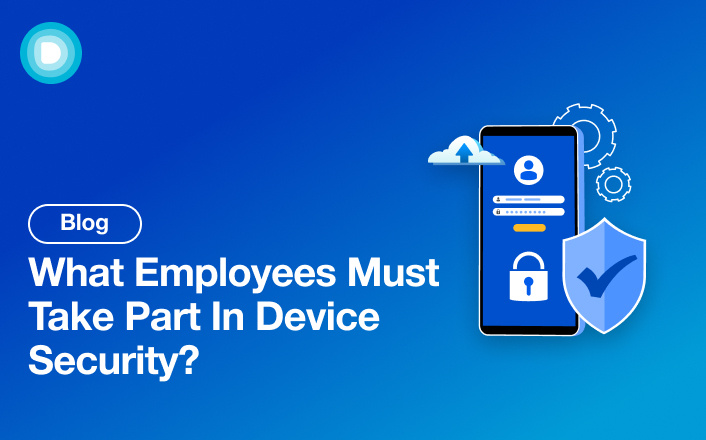- Product
-
Solution
-
By Industry
Cybersecurity solutions tailored to your industry’s needs.
-
- Resources
-
Books
Our ultimate guides and playbooks
Solution Briefs
Overview of PureDome’s functionality
-
Quizzes
Assess your cybersecurity readiness
Case Studies
PureDome customer success stories
Newsletter
Subscribe to the PureDome newsletter
-
- About Us
- Partner
- Pricing
- Download
What Employees Must Take Part In Device Security?
-
Aiman Ikram
-
28 May 2024
- 3 min read

.png?width=1728&height=836&name=Feature%20image-%20What%20Employees%20Must%20Take%20Part%20In%20Device%20Security_%20(1).png)
Device security has now become a critical concern for organizations of all sizes. With cyber threats evolving at an alarming rate, it's no longer sufficient for IT departments alone to shoulder the responsibility of safeguarding company data. Every employee, from entry-level staff to senior executives, plays a vital role in maintaining robust device security. This blog explores why device security is a shared responsibility and the essential practices all employees must adopt.
Why Device Security is Everyone's Responsibility
Device security is everyone's responsibility because cyber threats can target any employee, regardless of their role or level within the company. If just one person’s device is compromised, it can put the entire organization at risk. By using strong passwords and being cautious with emails and links, the company can better protect its data and systems from hackers and cyber attacks. Everyone's participation helps create a strong, united defense against potential security breaches.
The Role of Employees in Maintaining Device Security
- Vigilance: Be alert to potential security threats, such as phishing emails or suspicious links.
- Compliance: Follow company policies and guidelines for secure device usage.
- Updating: Ensure devices and software are regularly updated with the latest security patches.
- Password Management: Use strong, unique passwords and enable two-factor authentication.
- Reporting: Immediately report any unusual or suspicious activity to the IT department.
- Training: Participate in security training and awareness programs.
- Physical Security: Keep devices secure and avoid leaving them unattended in public places.
Key Device Security Practices for All Employees
Use Strong Passwords:
- Strong Passwords: Create passwords that are at least 12 characters long, using a mix of letters, numbers, and special characters. Avoid using easily guessable information like birthdays or common words.
- Two-Factor Authentication (2FA): Enable 2FA on all accounts where available. This adds an extra layer of security by requiring a second form of verification, such as a text message code or an authentication app, in addition to your password.
Regular Updates:
- Operating System Updates: Keep your device's operating system up to date. Manufacturers regularly release updates that fix security vulnerabilities.
- Software Updates: Ensure all applications and software on your device are updated to the latest versions. Many cyber attacks exploit outdated software.
- Automatic Updates: Enable automatic updates whenever possible to ensure you don’t miss critical security patches.
Phishing Awareness:
- Email Vigilance: Be cautious with emails from unknown senders, especially those with attachments or links. Look for signs of phishing, such as poor grammar, urgent requests, or unfamiliar email addresses.
- Education: Participate in regular training sessions to stay informed about the latest phishing tactics and how to recognize them.
- Verification: If you receive a suspicious email, verify its legitimacy by contacting the supposed sender directly through a known and trusted method.
Zero Trust Network Access (ZTNA):
- Principle of Least Privilege: Only grant access to applications and data that employees need to perform their jobs. This minimizes potential attack surfaces.
- Continuous Verification: Regularly verify the identity and security posture of users and devices before granting access to resources, ensuring they comply with security policies.
- Network Segmentation: Implement network segmentation to isolate different parts of the network, reducing the risk of widespread breaches.
- Micro-Segmentation: Break down network security into smaller, manageable segments to control access at a granular level.

Data Encryption:
- In Transit: Encrypt data when it is being transmitted across networks, such as emails or data transfers, to protect it from interception.
- At Rest: Encrypt data stored on devices, including hard drives and external storage, to protect it if the device is lost or stolen.
- Secure Connections: Use secure connections, such as HTTPS, for all web browsing and online activities to ensure data privacy and integrity.
The Importance of Regular Security Updates and Patches
Regular security updates and patches are crucial for keeping your devices and software safe from cyber threats. These updates contain fixes for vulnerabilities that hackers can exploit to gain unauthorized access to your system or steal your data.
By installing updates promptly, you close these security gaps and make it much harder for attackers to breach your defenses. Ignoring updates puts your devices and personal information at risk, so it's essential to stay vigilant and keep your software up to date at all times.
How PureDome Helps
PureDome helps by providing advanced security solutions that keep your devices and data safe from cyber threats. With features like real-time threat detection, automatic updates, and encrypted connections, PureDome ensures that your information remains secure at all times. Whether you're browsing the web, checking emails, or accessing sensitive documents, PureDome offers peace of mind by protecting you against hackers and malware.
Frequently Asked Questions
Why is device security important for employees?
Device security is essential for protecting company data and preventing cyber threats that can harm the organization.
What can employees do to improve device security?
Employees can improve device security by using strong passwords, staying vigilant against phishing attempts, and keeping their devices and software updated.
How does PureDome enhance device security?
PureDome enhances device security through real-time threat detection, automatic updates, and encrypted connections, ensuring that your information remains safe from cyber threats.